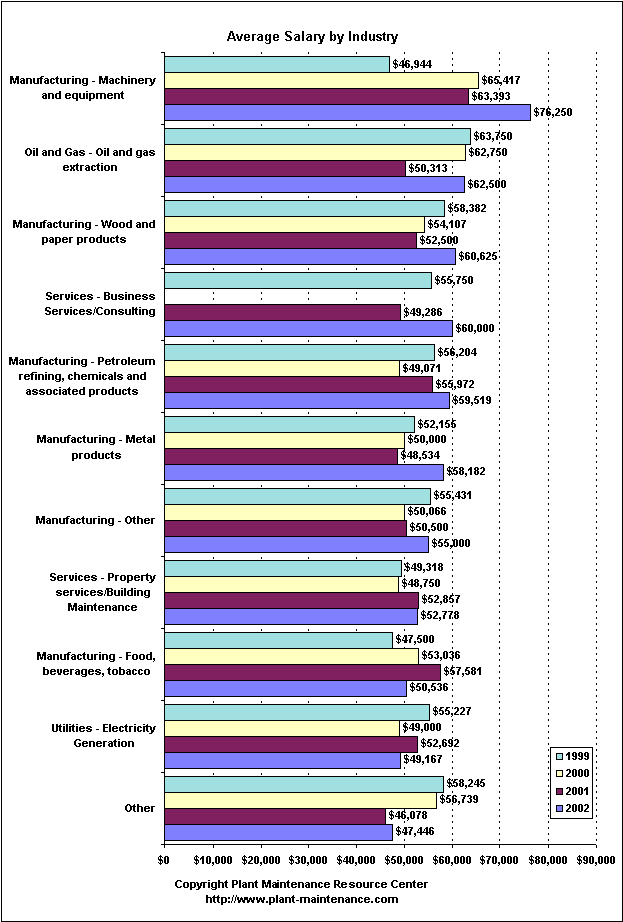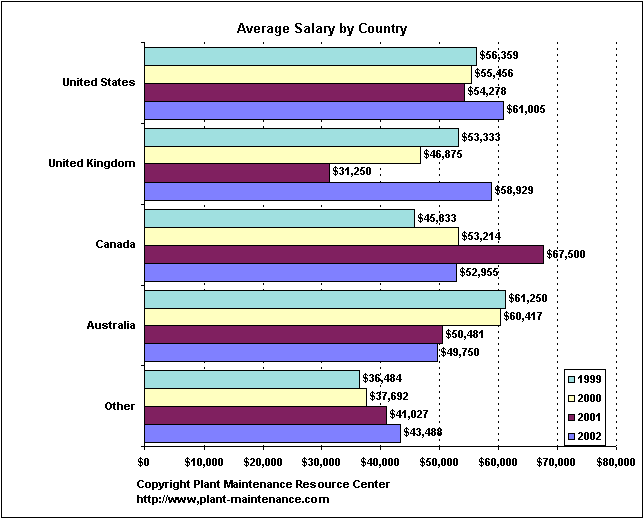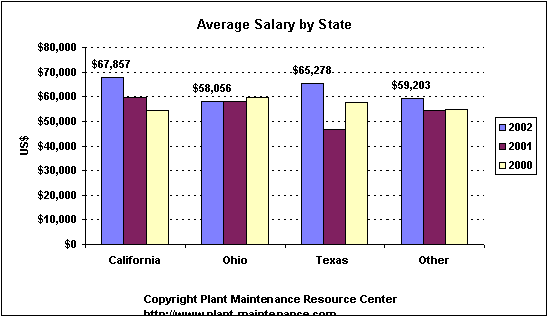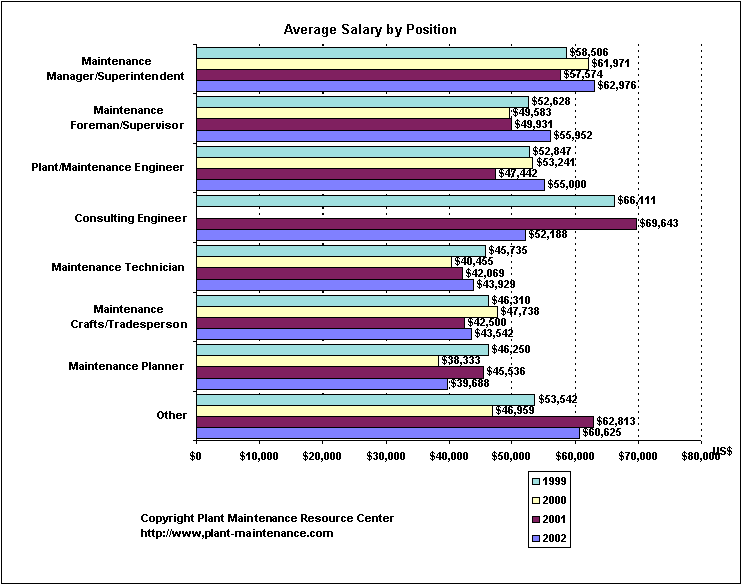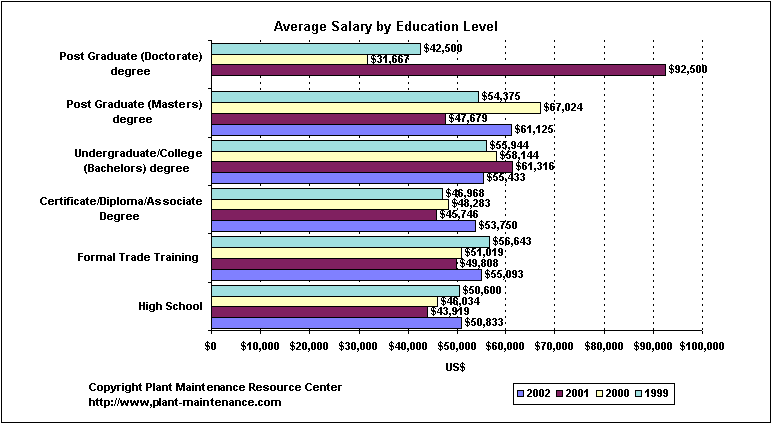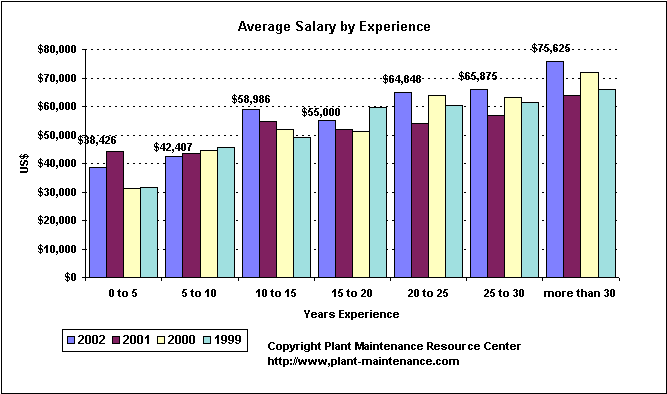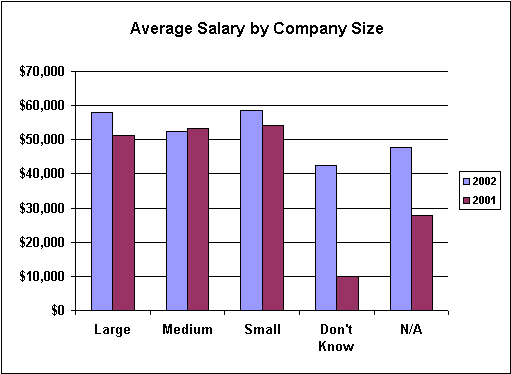|
| Plant Maintenance Resource Center
2003 Maintenance Salary Survey Results
| |
|
|
|
|
|
2003 Maintenance Salary Survey ResultsOverviewThe fifth annual survey of salaries in the Maintenance sector was conducted on the Plant Maintenance Resource Center website between January and March 2003. This salary survey is a regular, annual event. The 1999 Salary survey results are available here, and the 2000 Salary Survey results are available here. The 2001 Salary Survey results are available here, and the 2002 Salary Survey results are available here. The 2004 Maintenance Salary survey will open in mid-January 2004, so make a note to check back at the site then (if not before!). Raw Data - OverviewVoluntary (and confidential) responses were sought to the survey, and 158 valid responses were received. This was approximately 12% fewer than the 180 responses received in 2002, 36% fewer than the 248 responses received in 2001, and more than 50% fewer than the 320 responses received in 2000. We are unclear about the reasons for this continuing drop in response rate, given that this site is receiving approximately double the number of visitors in 2003 that it did in 2000. Raw Data - IndustriesThe greatest number of responses, once again, were from individuals in the Manufacturing industries. There was an increase in the number of respondents from the Petroleum industry, and a reduction in the number of respondents from the Food industry in this years survey, compared with last year. A complete list of industries represented in the last 4 surveys is tabulated below.
Raw Data - CountriesOver half of the responses received were from the USA, followed by Australia, the United Kingdom and Canada as the countries with the next greatest number of responses. In comparison with previous years, there is a much higher proportion of responses from the British, and a continued trend of declining participation from Americans.
Raw Data - Job PositionsAs in previous years, the positions with the greatest representation in the survey were Maintenance Managers/Superintendents, followed by Plant/Maintenance Engineers, Maintenance Foremen/Supervisors, Maintenance Technicians, Maintenance Planners and Maintenance Trades/Craftspeople.
Raw Data - Educational LevelsThe distribution of educational levels was similar to last year, although there appears to be a trend of an increasing number of respondents with Certificate/Diploma/Associate Degree qualifications, at the expense of lesser educational standards.
Raw Data - Work ExperienceA wide range of work experience was represented, with the distribution of experience being very similar to previous years.
Raw Data - SalariesThe total annual earnings, inclusive of all benefits, displayed a similar distribution to last year, with overall salaries slightly lower than previous years.
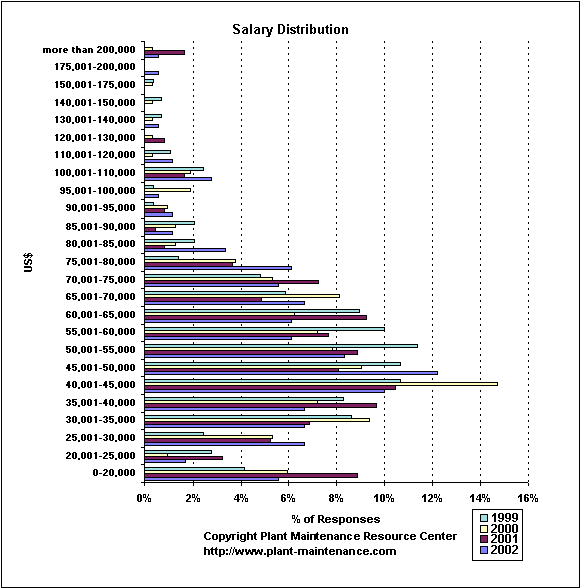 Overall ResultsThe median salary band was US$50,001-$55,000, up from the US$45,001-$50,000 in 2000 and 2001, but returning to the level of the 1999 survey. Assuming the average salary for each band is the midpoint of each band, the mean salary in 2002 is US$54,917. This is approximately US$3,600, or 7.1% higher than the 2001 mean of US$51,290, and approximately $2,400 or 4.6% higher than the mean 2000 salary of US$52,523. It is also around $1,400 or 2.5% lower than the mean salary of US$53,521 in 1999. However, the changing mix of respondents could explain some of this variation, rather than any underlying trend in salary movements. Salary by IndustryAn analysis of salaries by industry (for those industries with 5 or more responses) indicated that for the third year in a row, the industry paying the highest salaries was Manufacturing:Machinery and Equipment. Salaries being paid in Oil & Gas extraction returned to "normal" levels after the apparent aberration last year. Wood and Paper products and Consulting also appear to be financially rewarding industries for Maintenance professionals. Note that, for the purpose of this analysis, only industries containing 5 or more respondents were included. The overall result is shown graphically below.
Salaries by CountryOnce again, only countries with 5 or more respondents were included in this analysis, which showed that the highest salaries were to be obtained in the USA, followed by the United Kingdom, Canada and Australia. There was a remarkable apparent increase in UK salaries in comparison with previous years, but this may be due more to the greater number of UK respondents this year, and the different mix of respondents as a result. Canadian salaries apparently dropped last year, but it may be that the 2001 result was abnormally high. Australian salaries continue to fall in US$ terms as a result of the continuing decline of the value of the $A against the greenback. As usual, it should be noted that tax rates will differ between countries, as will the cost of living, so direct comparisons of salaries between countries should be treated cautiously. As already noted, changes in exchange rates mean that comparisons, year on year, for non-US countries should also be treated cautiously.
Salaries by StateAverage salaries are given for those states with more than 5 responses in the following chart. However, given the low number of results for each state, meaningful comparison between states is almost impossible.
Salaries by PositionYet again, only positions with more than 5 respondents were included in this analysis. After last year's abnormally high result for Consulting Engineers (as a result of the small number of respondents) Consulting Engineer salaries have fallen again to more "normal" levels. Not unsurprisingly, Maintenance Managers/Superintendents were the highest paid positions, followed, once again by Maintenance Supervisors/Foremen who were paid more than Plant/Maintenance Engineers, as they were last year Maintenance Planners continue to be paid less than Maintenance Foremen/Supervisors, and apparently, based on this year's result, are paid less than Maintenance technicians and Crafts/Tradespeople. Hardly an incentive to become a Maintenance Planner, and if this is true, an indictment on the value that industry gives to this role which is vital for ensuring ongoing plant and equipment reliability, and the effective and efficient use of Maintenance Labour.
Salary by EducationAgain, not unsurprisingly, it appears that increasing levels of formal educational qualifications generally lead to increasing salaries. This year, no responses were obtained for those with Doctorate level qualifications, and last year's result is probably distorted by there having only been one respondent with this qualification.
Salary by ExperienceOnce again, this survey highlights that experience is an important factor in generating additional salary.
Salary by Company SizeThis year's results appear to show that Medium sized organizations pay somewhat lower salaries than both large and small organizations, but it seems likely that these results are distorted by the other factors in the mix of respondents for each organization size.
ConclusionIn summary, the main conclusions from this survey are:
Throughout the year, the Plant Maintenance Resource Center runs a series of surveys on topics of interest to Maintenance professionals. To access the latest survey, visit here If you wish to copy or distribute this article, please email me to ask for permission first!
Copyright 1996-2009, The Plant Maintenance Resource Center . All Rights Reserved.
| ||||||||||||||||||||||||||||||||||||||||||||||||||||||||||||||||||||||||||||||||||||||||||||||||||||||||||||||||||||||||||||||||||||||||||||||||||||||||||||||||||||||||||||||||||||||||||||||||||||||||||||||||||||||||||||||||||||||||||||||||||||||||||||||||||||||||||||||||||||||||||||||||||||||||||||||||||||||||||||||||||||||||||||||||||||||||||||||||||||||||||||||||||||||||||||||||||||||||||||||||||||||||||||||||||||||||||||||||||||||||||||||||||||||||||||||||||||||||||||||||||||||||||||||||||||||||||||||||||||||||||||||||||||||||||||||||||||||||||||||||||||||||||||||||||||||||||||||||||||||||||||||||||||||||||||||||||||||||||||||||||||||||||||||||||||||||||||||||||||||||||||||||||||||||||||||||||||||||||||||||||||||||||||||||||||||||||||||||||||||||||||||||||||||||||||||||||||||||||||||||||||||||||||||||||||||||||||||||||||||||||||||||||||||||||||||||||||||||||||||||||||||||||||||||||||||||||||||||||||||||||||||||||||||||||||||||||||||||||||||||||||||||||||||||||||||||||||||||||||||

